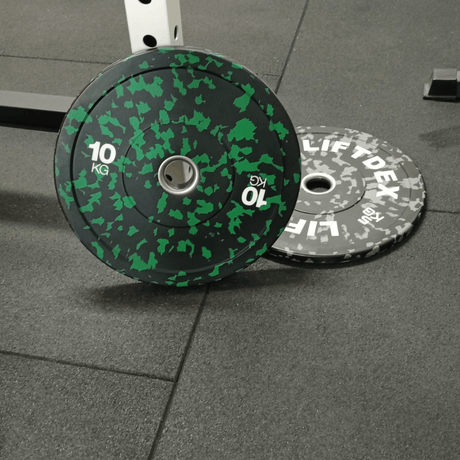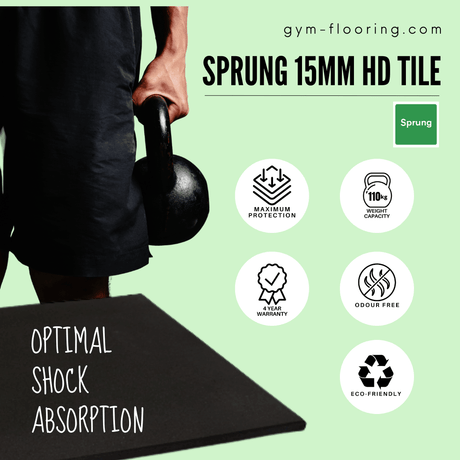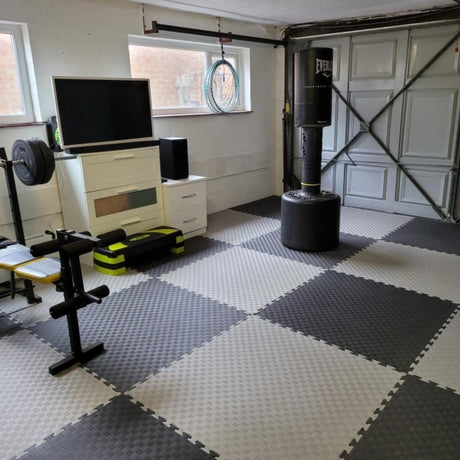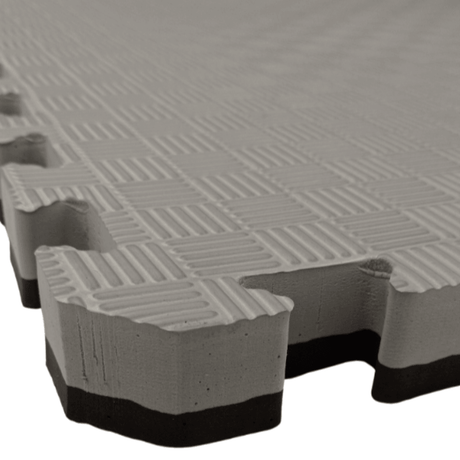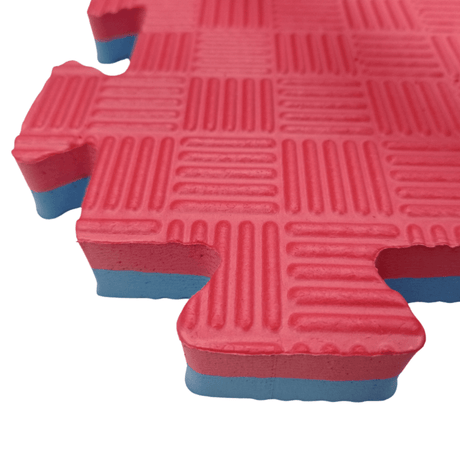Play is key to child development. Through play children discover their world, learn to interact with others and develop physically, mentally, emotionally and socially. One of the best ways to help babies and toddlers grow is through floor play. This can be rolling and crawling to sitting up and then walking. By getting down on the floor children can move their bodies in new ways, hone their motor skills and explore without feeling restricted.
One of the best ways to encourage more floor play and have a safe space is by using play mats. A play mat or baby mat is a cushioned surface that protects little ones as they roll, crawl and toddle. Whether you call them safety mats, playroom tiles or soft play mats, these versatile floor coverings are a great way to keep children safe and support their developmental needs.
In this article we’ll look at why play mats are so important for young children, the different types available and how to choose the right one for your needs.
Table of Contents
What is a Play Mat?
A play mat is a padded activity mat that gives babies and young children a safe and comfortable surface to play on. Made from foam or other soft materials these mats can be placed in living rooms, bedrooms, nurseries or playrooms to create a dedicated play area. Foam mats are one of the most popular options as they are lightweight, easy to move around and can be stored away or carried to a friend’s house or park with minimal fuss.Not only does a baby mat give children a secure spot to crawl, roll and test their balance it can also be placed in areas where you don’t want your child to wander – for instance away from stairs or certain pieces of furniture. When choosing a play mat you need to think about size, thickness and materials used to make sure the mat is suitable for your child’s age and safe for daily use.
Why Use a Play Mat?

Every parent wants to give their child the best environment to grow. A play mat can help you do just that by giving a snug, designated play space that’s hazard free.
- Protection from Hard Floors: Hard surfaces like wood or tile can be uncomfortable – and even unsafe – for little ones. A soft play mat cushions falls, protects delicate heads, knees and hands.
- Safe Place to Play: By laying out a mat you create a visual boundary that children recognise as their play area. This gives parents peace of mind knowing their child is on a child safety mat and less likely to hit their head on sharp edges or slip on a slippery floor.
- Stimulating Features: Many play mats have engaging features like mirrors, crinkly textures or colourful designs. These features stimulate sensory development by providing different sights, sounds and textures.
- Just Plain Fun: Children love bright colours and interesting textures. A lively play mat often becomes a favourite play spot and fires up their imagination.
- Easy Maintenance: Most mats are made from materials that are easy to clean – just wipe them down with a cloth or mild soapy water. This keeps germs at bay and your mat looking its best.
Types of Play Mats
With so many play mats on the market it can be hard to know which one is right for your little one. Here’s a breakdown of the main types:
Activity Play Mats
Activity mats have built-in toys – such as dangling rattles, mirrors and crinkle pads – and are designed to stimulate your baby’s senses and encourage tummy time. They’re perfect for early development helping little ones to start to coordinate movements and understand cause and effect. These mats are a great option for babies but your child may grow out of them quickly. If you are looking to keep costs down in the longterm, consider mats which support your child's growth.
Soft Foam Play Mats
Foam mats are popular because of their lightweight and portability. Made from EVA foam (anti-toxic) they provide a cushioned surface for crawling and are easy to arrange, store and assemble whenever you need. Many options have a textured surface which prevents slipping and falling such as Tatami EVA Foam Tiles.
Interlocking Puzzle Play Mats

Perfect for creating larger play areas these mats come in separate puzzle like pieces that fit together neatly. They’re a thicker foam mat (often 20mm to 40mm) and are easy to assemble or disassemble making them a flexible option for indoor or outdoor play.
Inflatable Play Mats
Inflatable mats made from PVC or similar materials can be blown up and deflated at will, they’re soft, bouncy and work indoors and out. This style of play mat tends to be geared towards older kids (rather than infants) who enjoy tumbling and bouncy play.
Carpet Play Mats
Carpet style mats have a bit more texture and are often colourfully patterned. While they look great in a room, carpets can absorb spills and stains more than foam or plastic mats so may need more frequent cleaning.
Playground Mats
This type of play mat is for outdoor use. Usually made from durable material such as rubber or PVC, these playground tiles protect children from injury during outdoor play, particularly when using play equipment such as climbing frames, swings and slides.
The Benefits of Using a Play Mat for Child Development

Beyond being a handy way to protect your floors and keep your child safe, play mats have real developmental benefits:
-
Cause and Effect - When a child bats a toy and it moves or makes a noise they’re beginning to understand that their actions have consequences. A baby mat often has interactive elements or an interesting texture so they have plenty of opportunities to experiment.
-
Motor Skills- As children crawl, roll and reach for toys on a play mat they’re working their muscles and refining gross and fine motor skills. Over time they’ll strengthen their neck, back, arms and legs and gain the coordination they need for sitting, standing and eventually walking.
-
A Soft Landing - We all know tumbles are part of the learning process. A soft play mat means fewer bumps and bruises as they explore and gives them the confidence to keep trying.
-
Encourages Social Interaction - If you have more than one child or have playdates, a play mat can be a shared space that promotes cooperation and communication. When children gather on a mat they’re more likely to interact, share toys and develop early social skills.
-
Cognitive Exploration - From bright colours and interesting shapes to attached toy features, play mats capture attention and encourage problem solving. As children figure out how to interact with what’s on the mat they’re building important cognitive skills like memory and critical thinking.
In Summary:

Choosing the Right Play Mat for Your Child
To find the perfect playroom matting for your play space, consider the following:
- Size: Make sure there’s enough room for your child to move around freely but consider your available space at home. A larger playroom mat might be great if you have space but if you’re limited a smaller mat or interlocking tiles could be more practical.
- Material: Choose mats made from non-toxic materials that are durable and easy to clean. Quality is key if you want the mat to withstand years of play. Look for products which come with a warranty which demonstrates their quality.
- Design & Installation: Check how easy the mat can be assembled, disassembled or stored away. Interlocking puzzle mats for example can be expanded or taken apart quickly. Think about whether you want something permanent or if you’d prefer a flexible solution that’s easy to tidy up at the end of the day.
- Budget: Balance your budget with the quality of the materials. You don’t have to break the bank but investing in a well made child safety mat or foam mat will often save you money in the long run as it will last longer and provide the best support for your child.
Tips for Looking After Your Play Mats
To keep your play mats in great condition:
- Clean Regularly: Wipe down the mat with a damp cloth or mild soapy water to keep it clean. This is especially important if your child is at the stage where they’re putting everything in their mouth!
- Inspect for Damage: Check for worn down edges, splits or missing puzzle pieces especially on interlocking or foam mats. If you see damage it may be time to replace or repair sections to keep the surface safe.
- Proper Storage: If you have limited space or only use the mat occasionally roll or fold it up (depending on the type) to protect it from damage when not in use.
Customer Feedback:
"I love the size of the foam mats. Being so big I was able to cover our whole play room then secure them down. Lovely feeling to walk on but feel strong like they will last a few years - I'm hoping!"
Conclusion
Play mats are so much more than a soft surface; they’re a vital tool in your child’s overall development. By providing a safe space to explore, encouraging social skills and offering plenty of sensory stimulation these mats become the foundation of early learning.
Whether you choose foam mats, interlocking puzzle tiles, you’ll be giving your child a fun and safe space to thrive.
Ready to find the perfect play mat for your little one? Browse our safe mats for play for tried-and-tested solutions in a wide choice of sizes and colours.





